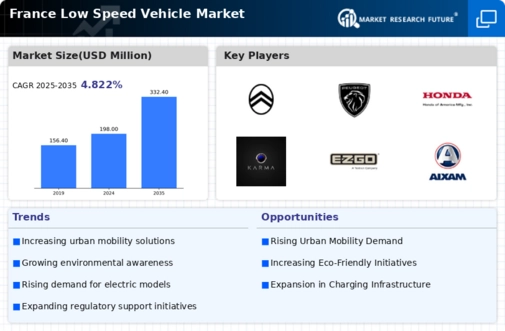The competitive landscape of the France Low Speed Vehicle Market is characterized by a dynamic interplay of innovation, regulatory compliance, and consumer preferences. As the demand for eco-friendly transportation solutions continues to rise, manufacturers in this segment are increasingly focused on developing vehicles that meet stringent emission standards while also catering to the needs of urban mobility. Local manufacturers are well-positioned to leverage their knowledge of regional markets, consumer behaviors, and technological trends, enhancing their competitive edges.
In addition to traditional automotive manufacturers, new entrants and start-ups introducing electric and low-speed vehicles are shaping the market dynamics, compelling established companies to rethink their strategies and invest in research and development to satisfy evolving consumer requirements. Collaborations, partnerships, and strategic alliances are also becoming vital for growth and innovation. Citroen stands out in the France Low Speed Vehicle Market with its strong heritage and commitment to designing vehicles that prioritize convenience and efficiency for urban settings.
The company is known for its innovative approaches, emphasizing comfort, practicality, and style in low-speed vehicles, making them a popular choice among city dwellers. Citroen's extensive dealership and service network across France ensure strong market presence, allowing for superior customer service and support. The brand's focus on electric mobility aligns with the growing demand for sustainable transport options, showcasing its strengths in product design and adaptability to changing market trends.
Furthermore, Citroen has established a reputation for reliability and quality, which adds to its appeal among consumers seeking low-speed vehicles that fulfill both functionality and aesthetic criteria.Peugeot also commands a significant presence in the France Low Speed Vehicle Market, recognized for its comprehensive range of electric and low-speed vehicles designed explicitly for urban use.The company has successfully positioned itself through innovative designs that combine efficiency with style, offering products that resonate well with the environmentally conscious consumer base. Peugeot's strengths lie in its technological advancements, including their commitment to enhancing battery life and vehicle performance.
The brand has engaged in strategic mergers and partnerships to bolster its capabilities in electric vehicle production, ensuring competitiveness in a rapidly evolving market.Its key products encompass electric city cars and compact utility vehicles tailored for lower speed environments, establishing Peugeot as a frontrunner in urban mobility solutions. The ongoing focus on research and development and sustainable practices further strengthens Peugeot's position in the France Low Speed Vehicle Market, reinforcing its industry leadership and adapting to future mobility challenges.




















Leave a Comment